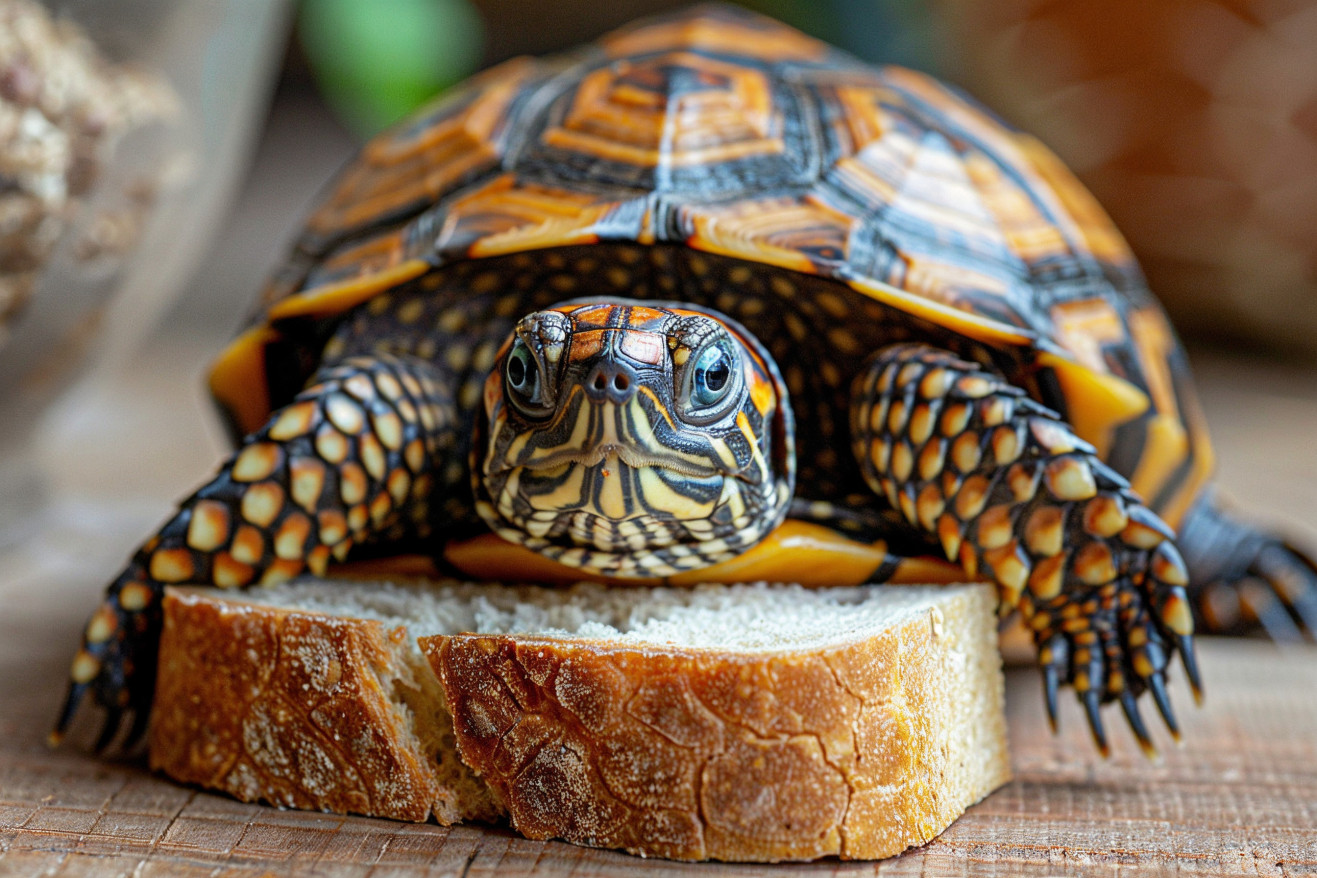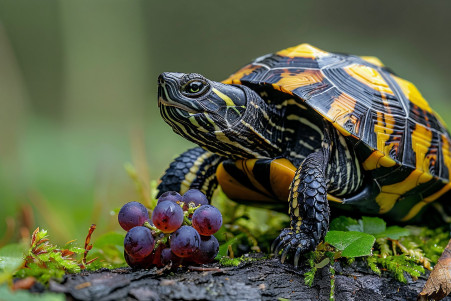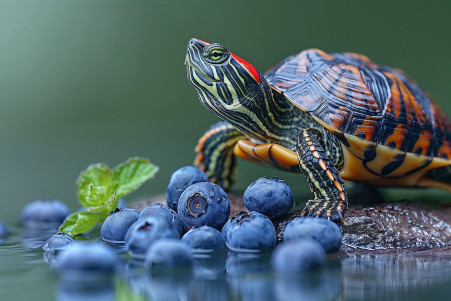Can You Give Bread to Turtles? Here's What You Should Know
13 June 2024 • Updated 11 June 2024

Although it may seem like a good idea to give turtles bread, especially if you have a lot of it lying around, is there any nutritional value in this popular snack for your pet reptile? The answer is no, you should not give bread to turtles. Not only does bread have little to no nutritional value for turtles, but it can also cause digestive issues and other health problems. Instead, turtles should be fed a diet that includes a variety of protein sources, such as feeder fish, as well as leafy greens, and calcium and vitamin supplements to ensure they get the nutrients they need.
While it's natural to want to share human food with pets, it's important to consider the scientific literature on turtle nutrition and digestion to determine what's actually appropriate. This article will explore the findings of veterinary research and expert opinions to shed light on the nuances of turtle care, including their nutritional requirements and the potential dangers of feeding them human foods like bread.
Can you give bread to turtles?
Potential Dangers of Feeding Bread to Turtles
Bread does not contain the nutrients that turtles need to grow and thrive. As noted in a study cited by Steemit, turtles lack the enzymes necessary to digest bread and similar foods, so they cannot digest or absorb the vitamins and minerals in it. This can lead to malnutrition, metabolic bone disease (a condition caused by a lack of calcium or vitamin D), and vitamin A deficiency (hypovitaminosis A), according to Hepper's article.
While a small amount of bread may not have an immediate impact, Pet Keen explains that if bread is regularly used as a substitute for a nutritious diet, turtles can quickly become deficient in the nutrients they need to survive. In addition, larger pieces of bread can cause digestive blockages or impaction, which can be fatal. Even small amounts of bread can cause a turtle's tank to become dirty, as it can cause the water to become cloudy and can lead to bacterial growth as it decomposes, according to the same Pet Keen article. In general, the lack of nutrients and potential for digestive problems and dirty tanks make bread a poor choice for turtles.
What to Do If Your Turtle Eats Bread
If your turtle eats a small amount of bread, there's no need to panic, says WebMD. However, you should watch your turtle carefully for signs of digestive problems, including a loss of appetite, lethargy, vomiting, and diarrhea. Pet Keen also recommends making sure your turtle's habitat is clean and that the temperature and humidity levels are where they need to be to ensure that your turtle's digestive system is working properly.
If your turtle doesn't show any signs of digestive problems, you can go back to feeding it its regular diet and make sure to avoid giving it any more bread or other processed foods. However, a JustAnswer expert suggests taking your turtle to the vet if it shows any signs of digestive problems for more than a day or two after eating bread, as this could be a sign of an underlying health issue.
Diet Recommendations for Different Types of Turtles
Box turtles are omnivores and should be fed a diet that is about 50% plant-based and 50% animal-based, according to VCA Animal Hospitals. Plant-based foods for box turtles should consist of dark, leafy greens like collard greens, kale, and mustard greens, with fruit making up no more than 10% of the diet. Acceptable animal-based foods include insects, worms, and eggs.
Aquatic turtles, meanwhile, should eat a diet that is 50% plant-based and 50% animal-based. Hikari Sales USA suggests a diet that includes a mix of commercial turtle pellets, leafy greens, occasional fruits, and protein sources like feeder fish and insects. PetSmart also says that pellets should be the primary food for aquatic turtles, with vegetables being fed to them 3-4 times a week and insects/feeder fish being fed to them once a week.
Baby and juvenile turtles are usually more carnivorous and need to be fed more often to keep up with their fast growth and development. PetSmart says that baby and juvenile turtles should be fed at least once a day. All turtle species need calcium and vitamin supplements and proper UVB lighting to ensure their shells and bones stay healthy.
How to Introduce New Foods and Change Diets
If you want to introduce new foods to your turtle, you should offer them in addition to the turtle's regular diet to stimulate interest, according to Turtle Forum. You can also try moving the new food around to make it seem like live prey to get the turtle's attention and encourage it to try something new.
To change your turtle's diet, you should gradually increase the amount of new foods while decreasing the amount of the old diet, according to the same Turtle Forum discussion. In addition, making your own turtle food can help you better manage portion sizes and nutrient content while you change your turtle's diet, according to PetHelpful.
It's important to be patient and not give up if your turtle doesn't immediately accept new foods. However, with these methods, turtle owners can add more nutritious options to their turtle's diet to help them stay healthy.
Healthy Bread Substitutes
WebMD says that a turtle's diet should consist of a lot of dark, leafy greens like romaine lettuce, collard greens, and kale. Other healthy vegetables like carrots, bell peppers, and squash can be given in moderation. Spreadhapiness.com also suggests low-fat protein options like feeder fish, crickets, and earthworms since they are important for healthy growth.
Some fruits like berries, melon, and mango can be given as treats in small amounts, according to Turtle OMG. In addition, commercial turtle pellets and supplements can help make sure that your turtle gets a well-rounded diet and all of the nutrients that it needs, according to PetSmart.
Conclusion: Make Sure Your Turtles Are Eating a Healthy Diet
Bread offers no nutritional value to turtles and can even cause health problems. A well-rounded diet that includes leafy greens, vegetables, proteins, and some fruits is necessary for a turtle's health. VCA Animal Hospitals notes that the carnivorous part of a turtle's diet should be no more than two-thirds for juveniles and about half for adults.
Dietary requirements will depend on the species of the turtle, as well as its age and life stage, so it's important to make sure you know what you should be feeding them. PetMD explains that adult turtles can be fed every two to three days, while juveniles are usually fed once a day. When you're trying to introduce new foods or change their diet, make sure you do it slowly and be patient.
If you're concerned about your turtle's diet, it's always a good idea to talk to your vet or a reptile expert. By making sure your turtle is eating a healthy diet, you can help them stay healthy and happy.


